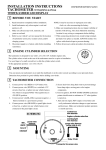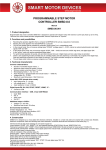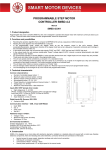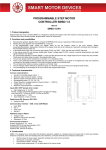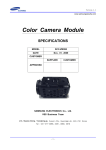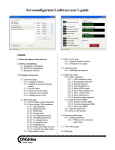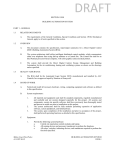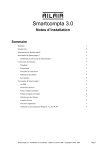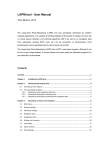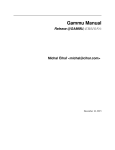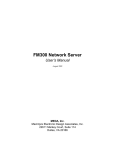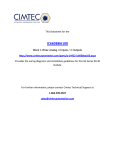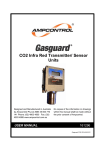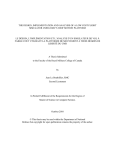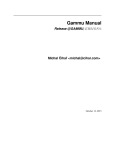Download PROGRAMMABLE STEP MOTOR CONTROLLER SMSD-822
Transcript
Commands loading to the controller’s memory – light both LED indicators. The SMSD-822 controller turns to this mode from the standby mode as receives the command “LD”. In the commands loading mode the controller accepts the executing commands only (table 7). After arriving the command “ED” the controller record all received executing commands to the memory and turns to the standby mode. Reading commands from the controller –light both LED indicators. The SMSD-822 controller turns to this mode from the standby mode. The sequence of executing commands from the controller memory transfers to the computer as the controller receives the command “RD”. After the commands transferred the controller turns back to the standby mode. Temporary stop mode –blink both LED indicators. The SMSD-822 controller turns to this submode during program executing as receives the signal «EN». The controller suspends program executing while the signal is active. As the signal turns to inactive the controller resumes the program executing. 10. Delivery in complete sets The stepper motor controller SMSD-822 1 pcs. SMC_Program can be delivered on a CD or by e-mail 1 pcs. Manual SMSD.822.000 1 pcs. Switch (Hall effect) SM8-31010NA – as an option, extra cost, on a request 1 pcs. 11. Warranty Any repair or modifications are performed by the manufacturer or an authorized company. The manufacturer guarantees the failure-free operation of the controller for 12 months since date of sale when the operation conditions are satisfied – section 3. The manufacturer sales department address: Smart Motor Devices OÜ, Tallinn Science Park Tehnopol, Mäealuse st. 4, Tallinn 12618, Estonia, Phone: + 372 6559914, e-mail: [email protected] url: http://www.stepmotor.biz SMART MOTOR DEVICES http://www.stepmotor.biz PROGRAMMABLE STEP MOTOR CONTROLLER SMSD-822 Manual SMSD.822.001 Date of sale: 2014 11 1. Product designation Programmable step motor controller SMSD-822 is designed to operate with hybrid two or four-phase stepper motor with maximum current per phase up to 8.0 Amp. Three control modes are provided: programmable, manual and simple driver. 2. Functions and possibilities Recording the operation algorithm from a computer to EEPROM of the unit as a sequence of commands. Reading the saved algorithm from the EEPROM to a computer. The unit can be controlled by computer (“direct control”) or can operate in a standalone mode. In the manual mode: the unit receives analog signal “SPEED” (voltage signal 0 – 5VDC, internal or external potentiometer) and digital signals “DIR” and “EN”. In the simple driver mode: the unit receives signals “STEP”, “DIR” – 0VDC low level and 24VDC high level, and digital signal “EN”. The tracking mode - position control by internal potentiometer or by analog signal 0…5V. For synchronized operation of several units and other devices there are 4 digital inputs/outputs/ There is zero positioning function provided (only in controller mode): start zero search by a command or by a signal on the digital input. Stop zero searching movement as input signal is received. The function provides homing by an individual input. If “Enable” signal is active motor motion is stopped. 3. Technical characteristic Table 1 Common characteristic: Number of controlled stepper motors Maximum output current per phase, Amp Minimum output current per phase, Amp Microstepping modes Pulse frequency in programmable and manual modes, Hz Voltage input Dimensions with connectors, mm Inputs DIR, STEP High voltage level, VDC Low voltage level, VDC Input resistance, kOhm, no less Digital inputs EN, START, RESET, HOME, “0” and IO1, IO2, IO3, IO4 in input mode: Contact to COM High voltage level of logic zero, VDC Input voltage on open contacts, VDC Input current on closed contacts, no more, mAmp IO1, IO2, IO3, IO4 in output mode: Signal type Maximum voltage on output, VDC Maximum load current, mAmp Analog input: Maximum current of analog input when input voltage is 5VDC, Amp Communication interface – USB, virtual COM RS232: baud bits parity stop bit Environmental Conditions: Ambient Temperature: (-25…+40)°C Humidity: 90%RH or less upon condition +25°C Condensation and freezing: none. Pressure: 650…800 mm of mercury 1 1 8.0 5.5 1/2; 1/4; 1/8; 1/16; 1/128; 1/256 1 – 10000 110 – 220 VAC 70 – 200 VDC 190x157x73 3.6 – 24 0 – 0.8 1.0 0.5 5 4.5 Open collector 24 20 10 9600 8 even 1 1 In “direct control” controller checks the value of acceleration: The motor is stopped: if while starting motion ( ) < 0 or = 0, acceleration and start speed will be ignored and the motor will start operation with the speed SD The motor rotates: ) < 0, where – current speed or = 0, acceleration will be ignored and the motor if ( will change its speed stepwise and remaining steps will be done with the speed SD. Table 8 Reply Description E10* The command successfully accepted E12* Interrupting or command execution by sending another command E14* Program executing completed E15* Communication Error (check port parameters) E16* Command error (check controller mode or ASCII code of the command) E19 * Command data error (check command data – integer, in allowed range, see table 6) 9. LED Manual mode (SW1 – OFF, SW2 – ON) The SMSD-822 is powered, step motor is stopped – light green color LED indicator. Step motor is rotating – blink green color LED indicator. EN signal is active – blink both LED indicators. Driver mode (SW1 – ON, SW2 – OFF) Light green color indicator. Controller mode (SW1 – ON, SW2 – ON) Standby mode – red color LED indicator. The SMSD-822 controller goes to the standby mode in one of the next cases: After program executing completed; After program executing was stopped by command «ST1». After power on (if microswitches SW1=On and SW2=On); After “Reset” button or input activated (if microswitches SW1=On and SW2=On). In the standby mode the SMSD-822 controller wait for one of the next event: Arrival one of the control commands from a computer (table 6, accepted commands are «LD», «RD», «ST»); Start executing program by pressing the button “Start” or input signal “Start” (connect “Start” and “Com”); Start searching for a limit switch (zero position) by pressing the “Home” button or input signal “Home” (connect “Home” and “Com”); Turn to the other operation mode: manual or simple driver modes (see section 6 and table 6). Program executing mode – blink red color LED indicator. The SMSD-822 controller turns to the program executing mode and start motion algorithm from the standby mode in case of: “Start” button pressed or input activated (connect “Start” and “Com”); Arrival the control command «ST»; The SMSD-822 controller turns back from program executing to the standby mode in case of: Executing program completed; Arrival the control command «ST»; “Reset” button pressed or input activated (connect “Reset” and “Com”). Waiting for an external signal submode – blink red color LED indicator. The SMSD-822 controller turns to this submode during program executing, as per the command “WHddd” or “WLddd” – waiting for an external signal. The controller suspends program executing till receiving active signal to input IO1, IO2, IO3 or IO4. As the signal arrives to IO1, IO2, Io3, IO4 (as per the command) the controller resumes program executing. 10 Command 21 MHddd (ddd=1…4) 22 MLddd (ddd=1…4) 23 HM 24 SPddd 25 LL 26 JPddd (1…255) 27 WLddd (ddd=1…4) 28 WHddd (1…4) 29 SCddd (1…100) Table 7 «Direct control» Continuous movement, till signal IOddd is removed: - if this command is received when the motor is stopped, Indefinite movement, till continuous motion will begin till signal IOddd is removed; - if this command is received while driving, from this signal IOddd is removed moment the motor will start continuous movement with the current speed till signal IOddd is removed. Continuous movement, till signal IOddd is set: - if this command is received when the motor is stopped, Indefinite movement, till continuous motion will begin till signal IOddd is set; - if this command is received while driving, from this signal IOddd is set moment the motor will start continuous movement with the current speed till signal IOddd is set. IO1, IO2, IO3, IO4 are used as inputs Continuous movement, till signal to input “0” (zero limit switch) Indefinite movement, till - if this command is received when the motor is stopped, signal to input “0” (zero continuous motion will begin till signal to input “0”; - if this command is received while driving from this limit switch) moment the motor will start continuous movement with the current speed till signal to input “0”; Pause: min 1ms – max 10000000ms After receiving this command the motor will stop and wait for ddd ms and then will continue to execute the remaining Pause for ddddd ms, m = steps. 100000000 If in pause time the commands MV, MVddd, MH, ML, HM a received, they are executed immediately and previous command is considered complete Set label for cycle Set label for cycle operation – for program in buffer operation Repeat from label ddd times, =255. Set 2 Repeat from label ddd times, max 255. Set 2 commands commands JPddd to create JPddd to create endless cycle endless cycle. Indefinite pause, wait removing signal IOddd - if this command is received when the motor is stopped, next command will be executed after signal IOddd is Indefinite pause, wait removed; removing signal IOddd - if this command is received while driving, from this moment the motor is stopped waiting removing signal IOddd the previous command is considered complete Indefinite pause, wait for a signal to input IN2 - if this command is received when the motor is stopped, next Indefinite pause, wait for a command will be executed after signal on the input IOddd; signal to input IOddd - if this command is received while driving, from this moment the motor is stopped waiting for a signal to input IOddd, the previous command is considered complete IO1, IO2, IO3, IO4 are used as inputs This command is accessible only in the tracking mode, and gives possibility to set the scale – the diapason of movement. The diapason = ddd•2000. Standalone mode 9 4. Construction SMSD-822 is designed as a circuit plate with electronic elements, installed on a heat sink plate and covered with a metal case. Besides electronic components, there are indicating and control elements, connection terminals and connectors on the board (img. 1). Img.1. SMSD-822 controller scheme Terminal screws for step motor windings (2) and power supply (1); Plug for input/output signals connection – 25pins (3); Control buttons “START”, “RESET”, and “HOME” (4); Internal potentiometer for speed adjusting and for tuning: “SPEED/TUNING” (5); Switches SW1 – SW8 (6) LEDs for indication of the controller status (7). USB plug for a computer connection (8). All inputs of the unit are opto-isolated. The numeration of input/output signals plug pins is shown in table 2. Table 2 View from the connector on the body of the SMSD-822 controller 2 1 2 3 4 5 6 7 8 9 10 11 12 13 Signal PUL DIR START HOME RESET «0» IO1 IO2 IO3 IO4 COM SPEED/Position +5V 14 15 16 17 18 19 20 21 22 23 24 25 Signal PUL DIR EN COM COM COM COM COM COM COM COM COM 5. Assembly and connection Please, learn this manual carefully before connection and assembly. Please, wire just when power is off. Do not attempt to change wiring while the power is on. Please, provide a reliable contact in connection terminals. During wiring, please, observe the polarity and wire management. ATTENTION: Power supply of the controller is dangerous for human’s health and life. It is necessary to observe rules of electro technical safety! You need to ground the controller! Assembly and connection order: 1. Connect the SMSD-822 controller with stepper motor, switches and electric power supplier according to one of schemes shown in images 2 – 8. 2. Connect if it is necessary the SMSD-822 controller to a computer by an interface USB cable. Command 5 9 10 11 Img.2. An example of scheme of power supply connection If you use the DC power supply – connect it to N, L terminals; the polarity is not important. 12 Logic signal source (high voltage level 24VDC) Connection schemes The connection examples are shown in the images 3 – 8. The switch connection example is shown in the image 9. 13 14 15 Img. 3. Driver mode connection example Img. 4. Manual mode connection example Img.5. Tracking mode connection example 16 17 18 19 3 RB - ED Complete executing commands sequence. After accepting this command the controller records all transferred commands into the memory and turns to the standby mode. 7 8 Standalone mode Table 7 «Direct control» Read the command sequence from the operational buffer. If this command is received while driving, the motor is stopped and turned off. Complete executing commands sequence. After accepting this command the controller record all commands to operational buffer and turns to the standby mode Set the address pointer in 0 Begin - start a new algorithm, the Begin - start a new algorithm in the buffer, the previous sequence is cleared. previous sequence is cleared. EN Set “enable” - turn on the motor DS Set “disable” - turn off the motor Forward motion - if the motor is stopped, the start of the motion will be in this direction; DL Forward motion - if this command was received while driving, the remaining steps are processed in the direction according this command Backward motion - if the motor is stopped, the start of the motion will be in this direction; DR Backward motion - if this command was received while driving, the remaining steps are processed in the direction according this command Reverse - if the motor is stopped, the start of the motion will be carried out in the opposite direction; RS Reverse - if this command was received while driving, the remaining steps are processed in the opposite direction 1 AL(-)ddd Acceleration ddd: min = -1000, max =1000 Speed: - if the motor is stopped the start of the motion will be carried out with this speed; if acceleration is used this SDddd Speed ddddd, max = 10000 command sets the final speed; if there is no acceleration (1 to 10000) steps/sec this speed will be used as start speed; - if this command was received while driving, the remaining steps are processed with this speed SSddd Start speed: This command is used only for starting motion and only when acceleration is used (AL 0) (1 to 2000) SFddd Set the flag in output IOddd. IOddd is used as output. (ddd=1…4) Remove the flag in output IOddd. IOddd is used as output. If one of the signals IOddd has CFddd been used as output, and then it is going to be used as input, this command must be set (ddd=1…4) before. Continuous motion - if the motor is stopped, this command starts perpetual motion; MV Continuous movement - if this command was received while driving, continuous motion with current speed begins BG 8 If the program is in the “simple control mode” - input motor operation parameters (steps number, speed, acceleration, direction) and press the button “write” to record parameters to the controller and press the button “start” to start motion according to the recorded command sequence. Or press the button “Write and start” to record new parameters and start motion at the moment. If the program is in the programming control mode add to the command list: Controller mode connection examples Home 4 Reset 5 «0» 6 EN 16 17...25 DIR 2 DIR 15 1kOhm Img. 6. Controller mode connection example Img. 11 Img 12 img 14 img 13 When “Direct control” is used in the “Programming control mode” it is necessary to check box “Direct control” and commands “Start loading”, “End loading” are not used. Command is executed as soon as it is written in Command window. Saving execute program with other terminal program with RS-232 communication function Set the port number (check in the windows device manager, image 11), set port parameters according to the table 1. Input required commands sequence using the ASCII codes (table 7, 8; section 8). 8. Commands Commands in the programmable mode should be byte-serial (character-serial) transferred. Every command should be completed with the ending character “*”. The ending character “\” instead of “*” cancels previous bytes transfer (whole string). There is the commands list in the table 7. The SMSD-822 controller receives and checks every command after receiving the ending character “*”. Controller sends to the communication port a reply after receiving every command (successful or error command). All possible controller replies are presented in the table8. Table 7 Command Standalone mode «Direct control» Start loading to the controller – after the 1 LD command controller is in the loading mode. Read the command sequence from the 2 RD controller memory. Start or stop the commands sequence executing Start if the controller in the After receiving this command, the motor will 3 ST programmable standby mode, stop if the stop immediately, the previous command is considered complete commands sequence is executing. Start loading to the operational buffer. 4 LB If this command is received while driving, the motor is stopped and turned off. 7 3 COM 1) «Start loading to the coordinate 1» ; 2) Add commands to assemble the operation algorithm; 3) «End loading» . 4) Press the button «send» under the command list. Commands list and description are in the section 8. “Commands”, and in the SMC_Program manual. After the commands sequence (operation algorithm) is recorded into the controller there are two possibilities: to continue control by the SMC_Program or to use the controller in standalone mode. To start program executing in the standalone mode press the “Start” button or contact “Start” and “GND” at the controller frame. Start Img. 7. IO1, IO2, IO3, IO4 inputs connection mode Img. 8. IO1, IO2, IO3, IO4 outputs connection mode It is unacceptable to use one of the signals as input and output at the same time. If it was used as output and then it will be used as input it is necessary to turn the flag off with the CFddd command (look the paragraph 8). Img.9. NPN switch connection example Motor connection The SMSD-822 controller provides operation with 2 or 4-phase stepper motors, 4, 6 or 8 wires. Winding connection examples are in the table 3. Connect step motor wires to A+, A-, B+ and B- terminals of SMSD-822. Table 3 Scheme 1 Scheme 2 Scheme 3 8 wires stepmotor connection (4 phases): Scheme 1 – serial connection; Scheme 2 – parallel connection. 6 wires stepmotor connection (2 phases with midpoint taps): Scheme 3; 4 wires stepmotor connection (2 phases without midpoint taps): Scheme 4 . 6. Before starting 1. Make sure the power supply is turned off. 2. Make assembly and connection according to paragraph 5. Chose the suitable current and set microsteps SW7, SW8 according to table 4. 4 Scheme 4 Current, Amp 5.5 OFF SW7 3. 6.2 ON contact EN-16 contact on COM – 17…25 contact) - power is removed from the motor windings. Inputs PUL and DIR are bidirectional, so the polarity of connected signals is not important. Table 4 8.0 ON 6.5 OFF OFF OFF ON ON SW8 Chose suitable microstepping mode and set micro switches SW3, SW4, SW5 according to table 5. Table 5 Microstepping mode 1/2 1/4 1/8 SW3 ON OFF ON SW4 OFF ON ON 1/16 1/32 1/64 1/128 1/256 OFF ON OFF ON OFF OFF OFF ON ON OFF OFF OFF OFF ON ON ON ON OFF SW5 Set the switch SW6 for automatic reduction of holding current: SW6 – ON 100%; SW6 – OFF 70%. 5. Chose suitable operation mode and set micro switches SW1, SW2 according to the table 6. There are three operation modes: controller, driver and manual. Also “Tuning” mode is provided for setting of the unit with the connected motor. Before starting the operation with the connected motor at the first time it is necessary to use “Tuning” to low vibration and resonance effect – look paragraph 7. Table 6 Operation mode SW1 SW2 Controller ON ON Manual (also entrance to the tracking mode) OFF ON Driver ON OFF “Tuning” OFF OFF If the unit is powered, the new operation mode is applied after RESET (by button or input signal). 6. Check wiring once again and turn on the power supply. 4. 7. Operation modes 7.1. Tuning When step motor is connected to SMSD-822 controller at first time it is necessary to make “Tuning” (SW1 and SW2 – OFF) to low vibration and resonance. Phase current is set according to table 4; microctepping mode is set according to the table 5. When the controller is powered motor starts to rotate. Set the potentiometer “SPEED/TUNING” so that the motor works without any vibrations and noise. When the successful result has been reached press HOME button – the controller will remember this setting. If stepmotor connected to the controller is changed it is necessary to make tuning again for new model of the motor. 7.2. Manual mode The speed is adjusted by the internal potentiometer SPEED or external potentiometer or analog signal 05VDC. Speed value is saved when leaving this mode, and it is restored when re-entry this mode. When the external potentiometer is used, it is necessary to set the minimum speed with internal potentiometer SPEED (fully clockwise position) and connect external potentiometer to terminals +5V / SPEED / COM (img.2), or connect contacts of analog signal source to terminals SPEED / COM (maximum current of analog input is 10 Amp when Uinput = 5V). To change direction it is necessary to set signal DIR: high level – one direction; low level – another direction. To start motion you need to push START button or use START/COM terminals. To stop motion you need to push START button once more or RESET button, in this case power is removed from the motor windings. If EN signal is used: high level – motor is stopped, low level – motor continues motion. When internal potentiometer SPEED is used two-zone speed control is provided. By default, potentiometer controls speed in diapason from 1step/sec up to 1000step/sec – accurate speed setting. If after changing speed potentiometer is moved to speed 1step/sec – coarse speed setting is turned on, now potentiometer controls speed in diapason from 1step/sec up to 20000step/sec. 7.3. Driver mode Connection example is shown in the image 3. One step (or microstep) executes as front edge of the voltage pulse on the “PUL” input (1, 14 contacts of the connector). Direction switches by changing voltage level on the “DIR” input (2, 15 contacts of the connector). The motor can be stopped by the active signal on the “EN” input (clean 5 Img.10. STEP and DIR input signals 7.4. Tracking mode This mode gives possibility to control the position by the internal potentiometer, or external potentiometer, or by the analog signal 0…5V. To select this mode it is necessary to set driver mode (SW1 – ON, SW2 – OFF). After that you need to press button RESET, while holding it, press START button. Then release RESET button, and hold START button until red LED will stop lighting. When the controller enters this mode it takes the current position of potentiometer or control voltage (at the inputs COM-11, Position-12) as “zero coordinate”. If you need to rotate motor in both sides, it is accessible to set the potentiometer in the middle position, or set 2.5V of control voltage before entering this mode. Increasing the voltage corresponds to the rotation of the motor in one direction; decreasing the voltage corresponds to the rotation of the motor in other direction. If You connect the controller to the PC you can set start speed (command SSddd*), acceleration (ALddd*); working speed (SDddd*). You need just send these commands to the controller. Also scale can be set by the command SCddd*. All these commands are saved in EEPROM of the controller, so further connection to the PC is not necessary. Scale setting example: Scale 1000 (SC1000* is used). Analog voltage 2.5V is used as “zero coordinate”. Changing voltage from 2.5V to 5V will correspond to 500steps (microsteps) of motor in one direction, and changing voltage from 2.5V to 0V will correspond to 500steps (microsteps) of motor in another direction. 7.5. Controller mode There are two possible variants of operation in this mode: Direct control: it gives the possibility to control the step motor in “real time” mode; Stand alone mode: for a standalone operation the executing program should be saved via USB (virtual RS-232), after that the USB cable can be disconnected. For virtual RS-232 communication the special driver USB-RS-232 should be installed to the computer. Please, save on computer hard drive the installation pack CP210x_VCP_Win2K_XP_S2K3.zip. Unpack and execute the exe file. Please, follow the instructions during the installation progress. As a result when the controller is connected to the PC, the additional program COM-port appears (CP2102 USB to UART Bridge Controller). The availability and the number of new port can be checked in windows device manager (Windows XP: On the desktop right-click on My Computer and click Properties or open the Control Panel and double-click the System icon. In the System Properties window click the Hardware tab. In the Hardware tab click the Device Manager button) – image 11. This COM-port should be used for communication with SMSD-822 controller. The port properties should be set in a terminal program according to the table 1. As a terminal program SMC_Program or some other software (software should provide RS-232 ASCII communication) can be used. The program is available and supplied with the SMSD-822 controller. SMC_Program The program should be copied to the hard drive of the computer. Unpack the program pack. SMC_Program doesn’t require registration and installation. The write read operations should be allowed in the program folder (carefully check for windows vista and windows 7). It is necessary to set port properties in SMC_Program. Menu “Port settings” > «Chose port» (image 12) chose the connected port number and press “Ok” (image 13).In the “simple control panel window” check the box 1, (coordinate 1 – img.14). 6






